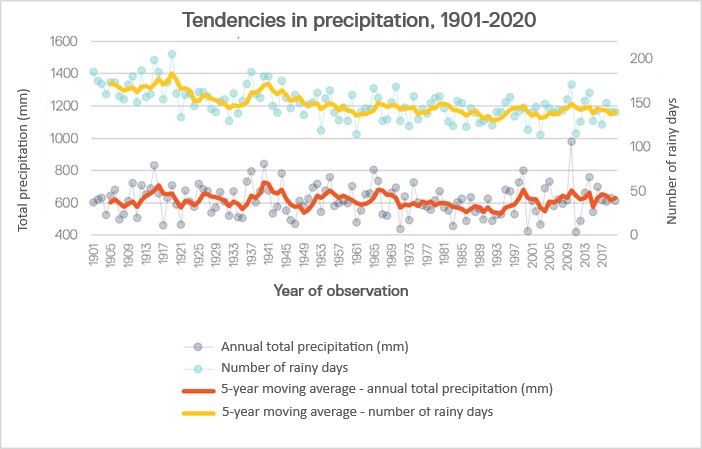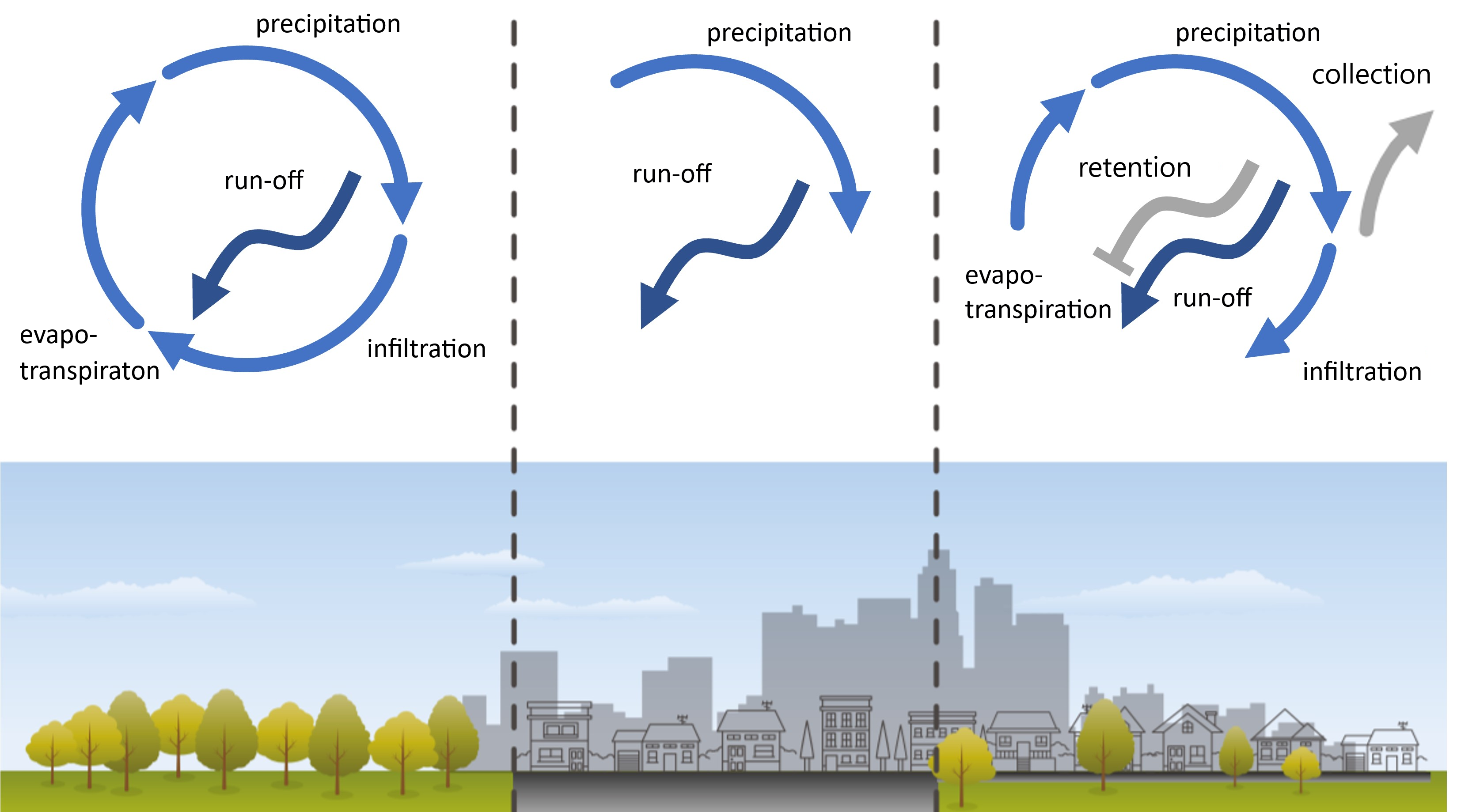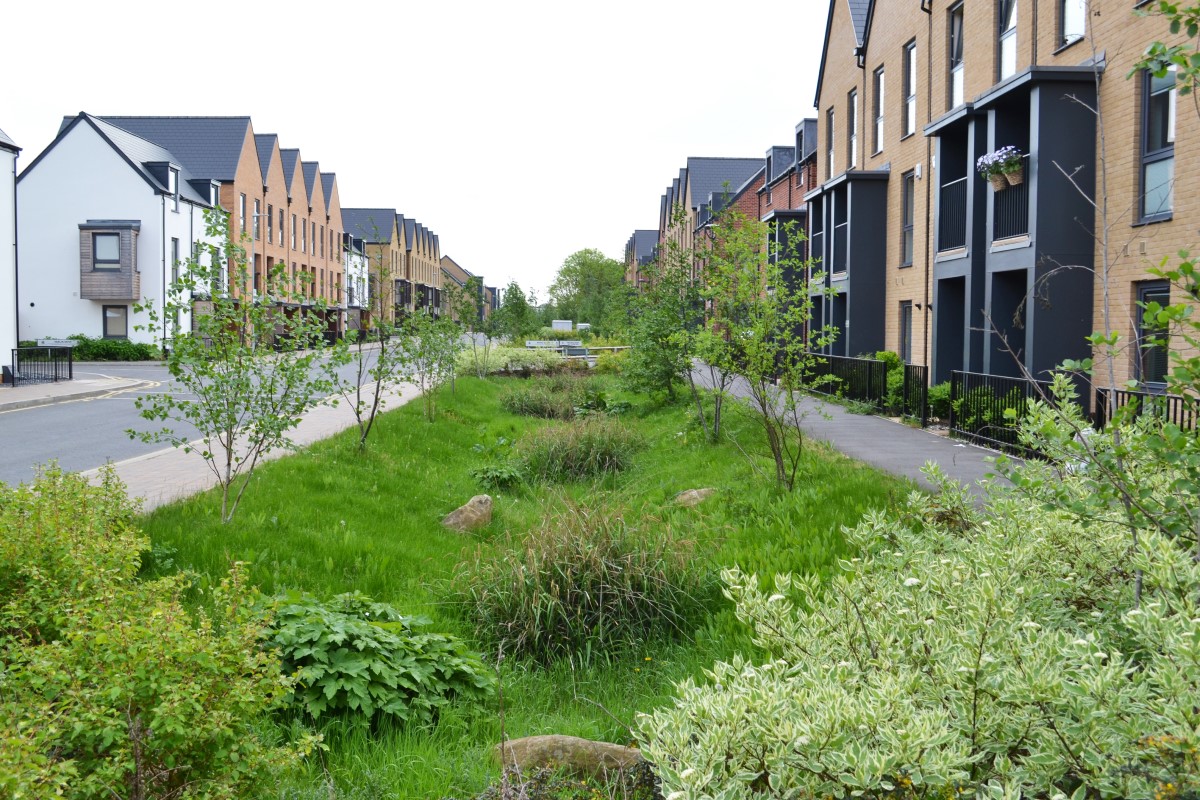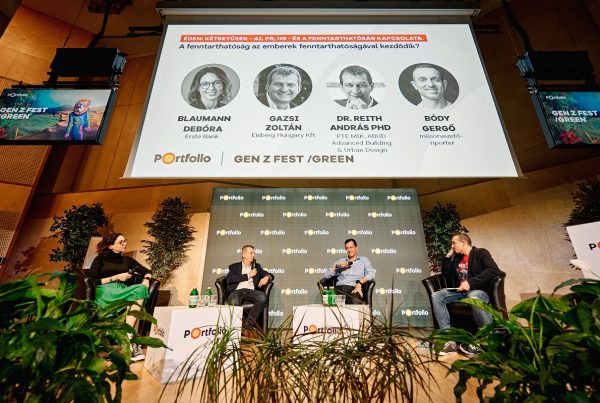NATURE-BASED SOLUTIONS 3.
Even unpredictable rain is worth a fortune
The next episode of our series on architecture and urban design has special relevance these days when rainfall is scarce. ABUD’s specialists explain how an integrated rainwater-management approach can tackle the impacts of climate change through the example of sustainable water management systems.
Fresh water had long been regarded and treated as an inexhaustible resource. We would build drains to divert rainwater as quickly as possible, while use potable water for irrigation. By now, however, considering the increasing amount of land affected by water shortages and drought, it has become obvious that water is a much more valuable and much less inexhaustible asset. The third article in the series is intended to give a brief summary of the ways in which a nature-based rainwater management approach– compared to traditional practices – can provide solutions to rainwater related problems caused by urbanisation and climate change. Most importantly, this approach views rainwater as an exploitable resource rather than a surplus to get rid of.
The challenges of rainwater management
Rising temperatures induced by climate change significantly contribute to the destabilisation of the hydrological balance, that is, the natural circulation of water. On the one hand, this negative process is due to the fact that higher temperatures accelerate evaporation. On the other hand, warm air’s physical characteristics allow it to carry more water vapour. According to rainfall data from the past 120 years, the number of rainy days (>1 mm) have dropped by an average of 17 days nationwide. Furthermore, the number of days with precipitation of more than 20mm have risen by 1.2 days in average per year, accompanied with precipitation totals diminishing by 4%. [Figure 1] Therefore, it can be inferred that precipitation is likely to arrive more frequently as intense occurrences of rainfall. Ultimately, dry periods will be 4 days longer on average and presumed to last even longer in the future, while they will more frequently be followed by extremely heavy rainfalls.[1] [2]
A heavy rainfall event in a short period cannot be utilised appropriately. It induces flash floods, accelerates soil erosion and the spread of surface water contamination, therefore causing significant harm in our built environment.

2/8 Weather data on Budapest and Hungary. Source: Hungarian Central Statistical Office (HCSO). [2]
Besides climate change, urbanisation has an adverse effect on the hydrological cycle, too: by increasing the proportion of paved surfaces and reducing that of vegetation, which increases the number of artificial run-off routes, rainwater cannot be utilised in the soil in a natural way. [3] Furthermore, as rainwater is rapidly drained, the intensity of evapotranspiration is significantly reduced, which contributes to further rises in temperature. As seen on diagram 2, due to anthropogenic influences, rainwater run-off is considerably increased, while evapotranspiration as well as surface and subsurface infiltration are reduced.

3/8 Natural and urban circulation of water. Source: Water sensitive planning in urban open spaces (Budapest) [4]
In recent years, extreme rainfall events and flash floods have often been reported in the media. In fact, many of us might even have encountered rainwater rushing on the streets. [Figure 3] In such cases, the size and capacity of the drainage system are often met with criticism. In the majority of Hungarian cities – including Budapest –, are more common with the exception of a few new developments. In the events of heavy rainfall, water reaching the combined system can cause overflow. Mixed rainwater and sewage flooding raises hygienic concerns (e.g., necessitates the disinfection of public spaces). In addition, contaminated water can reach surface waters. Extending the capacity of the drainage system is not a clear and workable solution, since in that case, the system should be optimised for extremely heavy rainfall becoming ever more common due to climate change, which would make the project disproportionately costly as well as largely unexploited for the greater part of the year – similarly to hypermarket car parks designed for Christmas peaks.

4/8 Flash flood at Szent Gellért Square, Budapest. Source: ABUD
Sustainable drainage systems as viable alternatives
These are exactly the problems that Sustainable urban Drainage Systems (SuDS) provide a solution for, when combined with the centralised drainage system. Planning a SuDS scheme is a system design exercise, which means the principles of adaptive environmental management should be followed. [Figure 4] This means that the system is primarily designed for resource utilisation, while excess precipitation is treated naturally and locally and only extreme overflows are released to the sewer system after a delay. [8]

5/8 Hierarchical approach to sustainable water management. Source: ABUD
SuDS schemes consist of linked components enabling a diversity of solutions. These systems chain different treatment facilities that exploit the potential of open drainage. Contrary to ordinary approaches of accumulating and draining rainwater as quickly as possible, SuDS offer a wide range of alternative solutions, such as the attenuation of surface water flow; accumulation of rainwater and utilisation at the point of entry; reduction of the volume of run-off into the sewer system; protection of the receiving watercourse from pollution – and all of this in a way that is suitable for the urban landscape. [Figure 5] As a general rule, we can say that the more components there are in a SuDS system, the more effectively we can achieve our goals regarding water management. In the next section, we will explore the operation of the most common SuDS components.

6/8 Hydrological cycles: natural cycle, urban cycle and cycle with sustainable urban rainwater management (left to right). Source: Water-sensitive planning in urban open spaces (Budapest). [4]
Examples of sustainable rainwater drainage
The first possible point of intervention for sustainable water management is where precipitation arrives. A popular way for such an intervention is building green roofs on the flat roofs of buildings and other structures. Consisting of a waterproofing layer, a drainage layer (depending on the design), soil and carefully selected plants, green roofs can contribute to water retention; delayed water dispatch; purification of rainwater due to single-layer or multi-layer vegetation and the increase of evapotranspiration. Intensive green roofs with higher maintenance needs are biologically more active than extensive ones with lower maintenance requirements. The former entails higher construction and operating costs but also offers ample social and recreational benefits. Precipitation can be accumulated from roofs and paved surfaces and channelled into water reservoirs of suitable sizes. The rate and volume of the run-off can therefore be attenuated, enabling rainwater storage for subsequent use. Another effective way to reduce the rapid water flow is the application of permeable pavements. Several types of permeable pavings are available for a variety of purposes, including poured surfaces (e.g. polyurethane rubberized running tracks) , or gravel paving. Their flexible application and contribution to the infiltration process is an advantage; nevertheless, applying them in contaminated areas, such as car parks and busy roads is not recommended, since they can damage the quality of soil and groundwater. [5] A notable local example of permeable pavement is the rainwater recycling system of the recently completed Vizafogó Park. [9]
From the point of entry, rainwater must be conveyed to its subsequent location of natural water treatment. Draining the water in pipes below the ground is a viable option, however, sustainable rainwater management prefers overground drainage for increased evaporation. Additionally, some organic matter can be removed from the water by aeration if a terraced system with a hydraulic jump is installed. Covered drains are an effective means to convey water, nevertheless, infiltration trenches covered by vegetation constitute a greater aesthetic and ecological value due to their increased evapotranspiration, delaying and infiltration of run-off, in addition to providing an ecological corridor between natural and urban areas. With the increase of vegetation, biofiltration is facilitated by micro-organisms on plant roots, taking up nitrogen, phosphorus, and contaminants from water for their own benefit. In case the size of the area is limited but the primary goal is the attenuation of run-off and saving drainage capacity for the sewer system, building rain gardens can provide a solution. These components can effectively purify contaminated rainwater and are appropriate for conveying water from infrequent rainfall events into the drain with a suitable delay. This is due to their special design as well as the drought and flood resistant properties of the plants. Operational considerations are key in the design of grassy ditches and rain gardens. Contaminants may be washed in from the road such as trash and sludge, reducing the efficiency of the system, thus their maintenance is a necessity. Moreover, the local climate must also be considered, since the overpopulation of insects in flooded areas can cause issues in Hungary, while in England it would probably not. In overall, a whole ecosystem is designed through this process, not just a piece of art. [Figure 6]

7/8 Left side: Ditch covered by vegetation. Source: allenpyke.co.uk (St. Andrews Park) [7] – Right side: Rain gardens along the road. Source: susdrain.org case study: Greening streets, retrofit rain gardens, Nottingham
In case a larger area is available, interventions of greater ecological value become possible. Large roots of the vegetation filters and purifies water in the trench, due to which infiltration becomes safe in terms of groundwater quality. In addition, the process facilitates evapotranspiration, which is not the least beneficial to microclimate regulation. The area is only flooded when it rains. Green spaces and specifically adapted urban environments, like football fields may be appropriate for this purpose. Retention ponds on the other hand are deeper, permanently flooded reservoirs that are also paired with an elevated infiltration zone. In the event of rainfall, water leaves the basin, then dries out and evaporates in the temporarily inundated infiltration zone. These components – as shown in Figure 7 – are areas accessible to citizens and have great aesthetic value. Moreover, besides supporting the biodiversity of wetlands, they contribute to microclimate regulation as well. Operational considerations described in the previous paragraph are also notable and the maintenance of larger areas accessible to citizens represents another challenge. This task – previously undertaken by civil engineers – now requires a collaborative design involving landscape designers and urban planners.

8/8 Left side: detention basin. Source: susdrain.org [6] – Right side: retention pond. Source: Water sensitive planning in urban open spaces (Budapest). [4]
Conclusion
Combined with nature-based solutions, sustainable rainwater management practices offer a viable alternative compared to previous methods. However, contrary to traditional views, a holistic perspective and integrated design approach is necessary for their successful application. The planning and operation of SuDS components require knowledge in the fields of hydrogeology (run-off-retention-overflow-infiltration planning), biochemistry (biofiltration planning and operation), ecology (from selecting the appropriate plants to initiating the self-sustaining and self-regulating ecological processes), technical engineering (integration into the utility service infrastructure), urbanism and landscape architecture (addressing community and aesthetic demands) – ultimately, a close cooperation between different sectors. Most importantly, a paradigm shift is necessary, as the result of which we do not regard water as an unnecessary burden to be eliminated, but rather an exploitable resource, through which water systems are created that are accessible and utile both to us and other species. Being aware of our responsibility as well as the increasingly lengthy dry periods expected in the future due to climate change, we cannot continue to waste rainwater any longer. The main advantage of SuDS systems is their potential to provide permanent solutions to rainwater management issues as opposed to quick fixes, taking into account both social and ecological factors.
Anna Gaál – Consultant, ABUD – Advanced Building and Urban Design
Viktor Bukovszki – Senior Consultant, ABUD – Advanced Building and Urban Design
References
[1] Innovációs és Technológiai Minisztérium (2018): Második Nemzeti Éghajlatváltozási Stratégia (NÉS-2)
[2] KSH (2021): 15.1.1.36. Magyarország és Budapest időjárásának adatai. URL: https://www.ksh.hu/stadat_files/kor/hu/kor0037.html
[3] Ambika Khadka, Teemu Kokkonen, Tero J. Niemi, Elisa Lähde, Nora Sillanpää & Harri Koivusalo (2020) Towards natural water cycle in urban areas: Modelling stormwater management designs, Urban Water Journal, 17:7, 587-597, DOI: 10.1080/1573062X.2019.1700285
[4] Budapesti Fővárosi Főpolgármesteri Hivatal (2018): Vízérzékeny tervezés a városi szabadtereken. URL: https://budapest.hu/Documents/V%C3%A1ros%C3%A9p%C3%ADt%C3%A9si%20F%C5%91oszt%C3%A1ly/ZOLDINFRASTRUKTURA_csapdek_10_01_online.pdf
[5] Budapest Főváros Városépítési Tervező Kft. (2016): Vízáteresztő burkolatok. URL: https://greenfo.hu/wp-content/uploads/2019/07/Z%C3%B6ldinfrastrukt%C3%BAra-f%C3%BCzetek-1-V%C3%ADz%C3%A1tereszt%C5%91-burkolatok.pdf
[6] Susdrain.org
[7] Alley Pyke Associates. URL: https://allenpyke.co.uk/news/st-andrews-park-wins-suds-award/
[8] Ballard et al. (2015): The SuDS Manual (C753F). URL: https://www.ciria.org/ItemDetail?iProductCode=C753F&Category=FREEPUBS
[9] Építészfórum (2022): Átadták a XIII. kerületi Vizafogó parkot. URL: https://epiteszforum.hu/atadtak-a-xiii-keruleti-vizafogo-parkot



